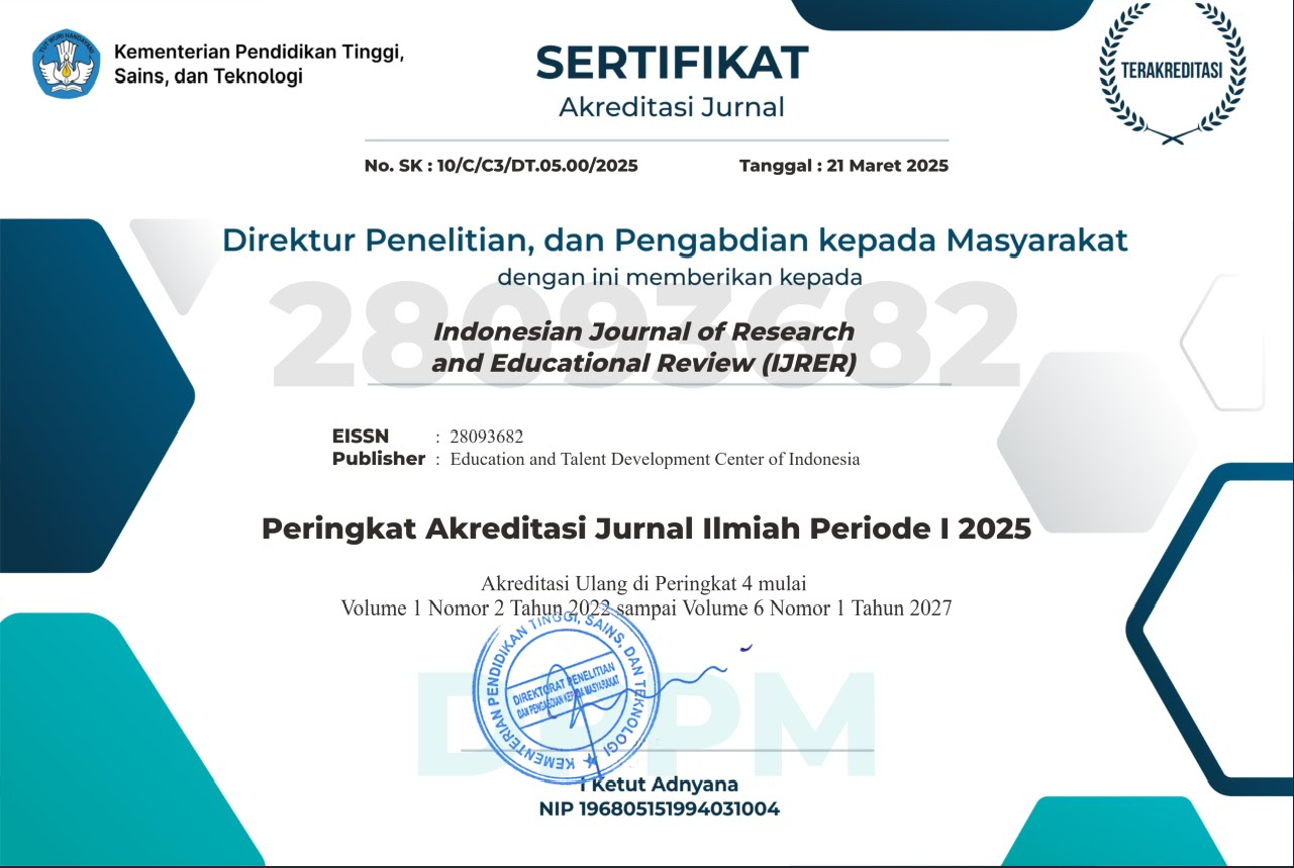Analysis of Students' Mathematical Reasoning Abilities on Matrix Material at Senior High School
DOI:
https://doi.org/10.51574/ijrer.v3i4.2176Keywords:
Mathematics Reasoning, Matrix Material, Senior High SchoolAbstract
The objective of this study is to describe the mathematical reasoning abilities of eleventh-grade students at public senior high school 1 Limboto, focusing on matrix material. This type of research employs quantitative methods and descriptive approaches. The subjects of the research consisted of 30 students from grade XI (IPA 1). Data collection was conducted through tests designed to measure various indicators of mathematical reasoning abilities. The results indicated that, overall, students' mathematical reasoning abilities fell into the moderate category, with a percentage of 69.33%. Further analysis based on the reasoning indicators revealed varied results: the ability to write mathematical statements was categorized as moderate (82.22%); the ability to perform manipulations was categorized as high (86.67%); the ability to find patterns in mathematical phenomena was moderate (74.67%); and the ability to draw conclusions from solutions was categorized as very low (39.26%). These findings highlight the need for greater attention to drawing conclusions in the learning process so that students can enhance their overall mathematical reasoning abilities.
References
Anggraini, A., Syofiana, M., & Ramadianti, W. (2023). Analisis kemampuan penalaran matematis siswa berbasis masalah pada materi bilangan pecahan. RANGE: Jurnal Pendidikan Matematika, 4(2), 267-277.
Bakker, A., Cai, J., & Zenger, L. (2021). Future themes of mathematics education research: An international survey before and during the pandemic. Educational Studies in Mathematics, 107(1), 1-24.
Banerjee, P. A. (2016). A systematic review of factors linked to poor academic performance of disadvantaged students in science and maths in schools. Cogent Education, 3(1), 1178441.
Clements, D. H., & Sarama, J. (2020). Learning and teaching early math: The learning trajectories approach. Routledge.
Dindyal, J., Schack, E. O., Choy, B. H., & Sherin, M. G. (2021). Exploring the terrains of mathematics teacher noticing. ZDM–Mathematics Education, 53(1), 1-16.
Gustiadi, A., Agustyaningrum, N., & Hanggara, Y. (2021). Analisis Kemampuan Penalaran Matematis Siswa dalam Menyelesaikan Soal Materi Dimensi Tiga. Jurnal Absis: Jurnal Pendidikan Matematika Dan Matematika, 4(1), 337-348.
Ibrahim, R. Y., Arsyad, A., & Katili, N. (2022). Analisis kesulitan pada materi operasi hitung bilangan pecahan kelas 5 sekolah dasar. Laplace: Jurnal Pendidikan Matematika, 5(1), 12-18.
Jiang, R., Liu, R. D., Star, J., Zhen, R., Wang, J., Hong, W., ... & Fu, X. (2021). How mathematics anxiety affects students' inflexible perseverance in mathematics problem‐solving: Examining the mediating role of cognitive reflection. British Journal of Educational Psychology, 91(1), 237-260.
Jonsson, B., Granberg, C., & Lithner, J. (2020). Gaining mathematical understanding: The effects of creative mathematical reasoning and cognitive proficiency. Frontiers in psychology, 11, 574366.
Khairani, B. P., & Gustianingrum, K. (2021). Analisis kesalahan siswa kelas XI SMA pada materi matriks. Mosharafa: Jurnal Pendidikan Matematika, 10(3), 505-514.
Lestari, M., Subanji, S., & Irawati, S. (2022). Analisis Kemampuan Penalaran Matematis Siswa SMA pada Materi Matriks. AKSIOMA: Jurnal Program Studi Pendidikan Matematika, 11(1), 550.
Maass, K., Geiger, V., Ariza, M. R., & Goos, M. (2019). The role of mathematics in interdisciplinary STEM education. Zdm, 51, 869-884.
Malanua, M. K., Pomalato, S. W. D., & Damayanti, T. (2024). Kemampuan Literasi Matematika Siswa Dalam Menyelesaikan Soal Cerita Aljabar Ditinjau Dari Self Efficacy Matematika. FIBONACCI: Jurnal Pendidikan Matematika dan Matematika, 10(1), 1-20.
Mareta, A., Sa'dijah, C., & Chandra, T. D. (2021). Analisis Kesalahan Siswa SMA dalam Menyelesaikan Soal Cerita Materi Matriks. Jurnal Cendekia: Jurnal Pendidikan Matematika, 5(2), 1238-1248.
Mukuka, A., Mutarutinya, V., & Balimuttajjo, S. (2021). Mediating Effect of Self-Efficacy on the Relationship between Instruction and Students' Mathematical Reasoning. Journal on Mathematics Education, 12(1), 73-92.
Muzaini, M., Hasbi, M., & Nasrun, N. (2021). The Role of Students’ Quantitative Reasoning in Solving Mathematical Problems Based on Cognitive Style. Vygotsky: Jurnal Pendidikan Matematika dan Matematika, 3(2), 87-98.
Pauweni, K. A., Uwange, D. I., Ismail, S., & Kobandaha, P. E. (2022). Peningkatan Hasil Belajar Siswa pada Materi Teorema Pythagoras Menggunakan Aplikasi Geogebra di Kelas VIII SMP Negeri 15 Gorontalo. Jurnal Cendekia: Jurnal Pendidikan Matematika, 6(3), 2660-2672.
Olsson, J., & Granberg, C. (2024). Teacher-student interaction supporting students’ creative mathematical reasoning during problem solving using Scratch. Mathematical Thinking and Learning, 26(3), 278-305.
Rohati, R., Kusumah, Y. S., & Kusnandi, K. (2023). Exploring students’ mathematical reasoning behavior in junior high schools: A grounded theory. Education Sciences, 13(3), 252.
Säfström, A. I., Lithner, J., Palm, T., Palmberg, B., Sidenvall, J., Andersson, C., ... & Granberg, C. (2024). Developing a diagnostic framework for primary and secondary students’ reasoning difficulties during mathematical problem solving. Educational Studies in Mathematics, 115(2), 125-149.
Smit, R., Bachmann, P., Blum, V., Birri, T., & Hess, K. (2017). Effects of a rubric for mathematical reasoning on teaching and learning in primary school. Instructional science, 45, 603-622.
Supriadi, N., & Suherman, S. (2024). The role of learning anxiety and mathematical reasoning as predictor of promoting learning motivation: The mediating role of mathematical problem solving. Thinking Skills and Creativity, 52, 101497.
Szabo, Z. K., Körtesi, P., Guncaga, J., Szabo, D., & Neag, R. (2020). Examples of problem-solving strategies in mathematics education supporting the sustainability of 21st-century skills. Sustainability, 12(23), 10113.
Taha, R., Badu, S. Q., & Arsyad, A. (2022). Meningkatkan Hasil Belajar Siswa Melalui Model Pembelajaran Kooperatif Tipe Team Assisted Individualization. Jambura Journal of Mathematics Education, 3(2), 147-154.
Tambychik, T., & Meerah, T. S. M. (2010). Students’ difficulties in mathematics problem-solving: What do they say?. Procedia-Social and Behavioral Sciences, 8, 142-151.
Une, D. F., Hulukati, E., Ismail, Y., Abdullah, A. W., & Usman, K. (2022). Hubungan Antara Gaya Belajar Dengan Kemampuan Kognitif Matematika Pada Materi Lingkaran di SMP Negeri 2 Limboto. Research in the Mathematical and Natural Sciences, 1(1), 54-60.
Utami, A. K. S., & Haerudin, H. (2021). Analisis kesulitan siswa dalam menyelesaikan soal kemampuan berfikir logis matematis. ANARGYA: Jurnal Ilmiah Pendidikan Matematika, 4(1), 55-61.
Yunus, N. A., Hulukati, E., & Djakaria, I. (2020). Pengaruh pendekatan kontekstual terhadap kemampuan penalaran matematis ditinjau dari gaya kognitif peserta didik. Jambura Journal of Mathematics, 2(1), 30-38.









1.png)













